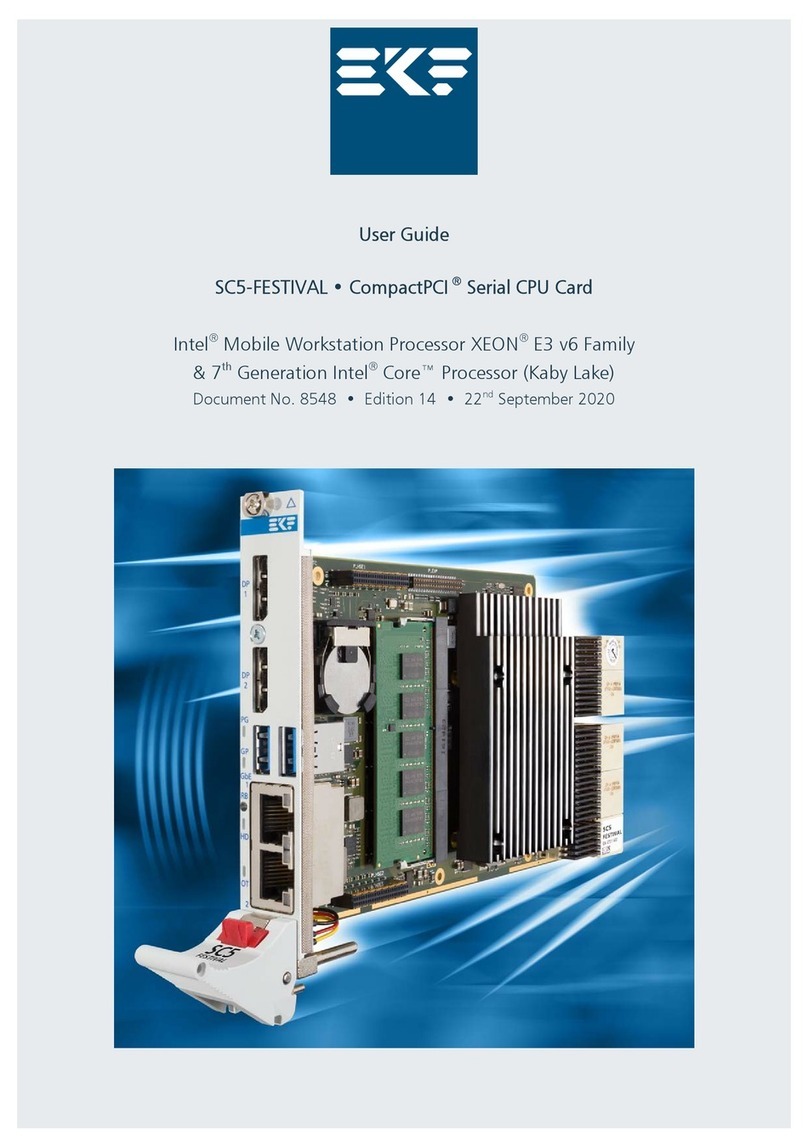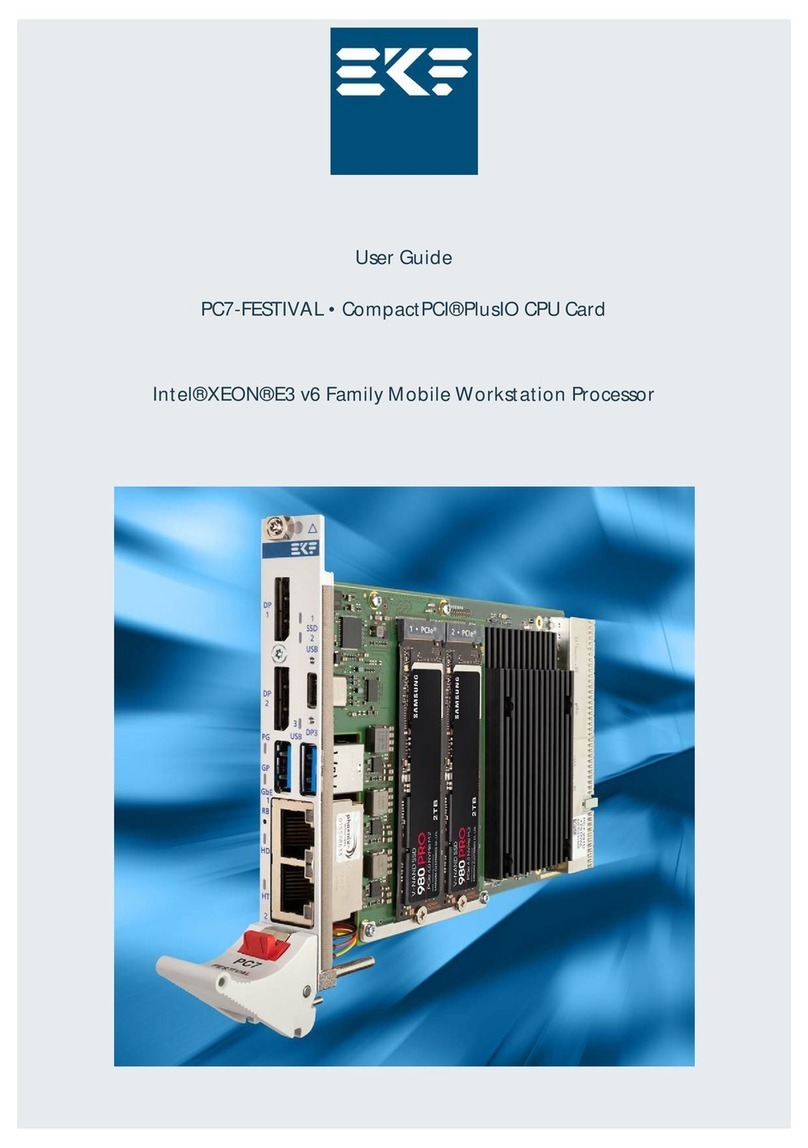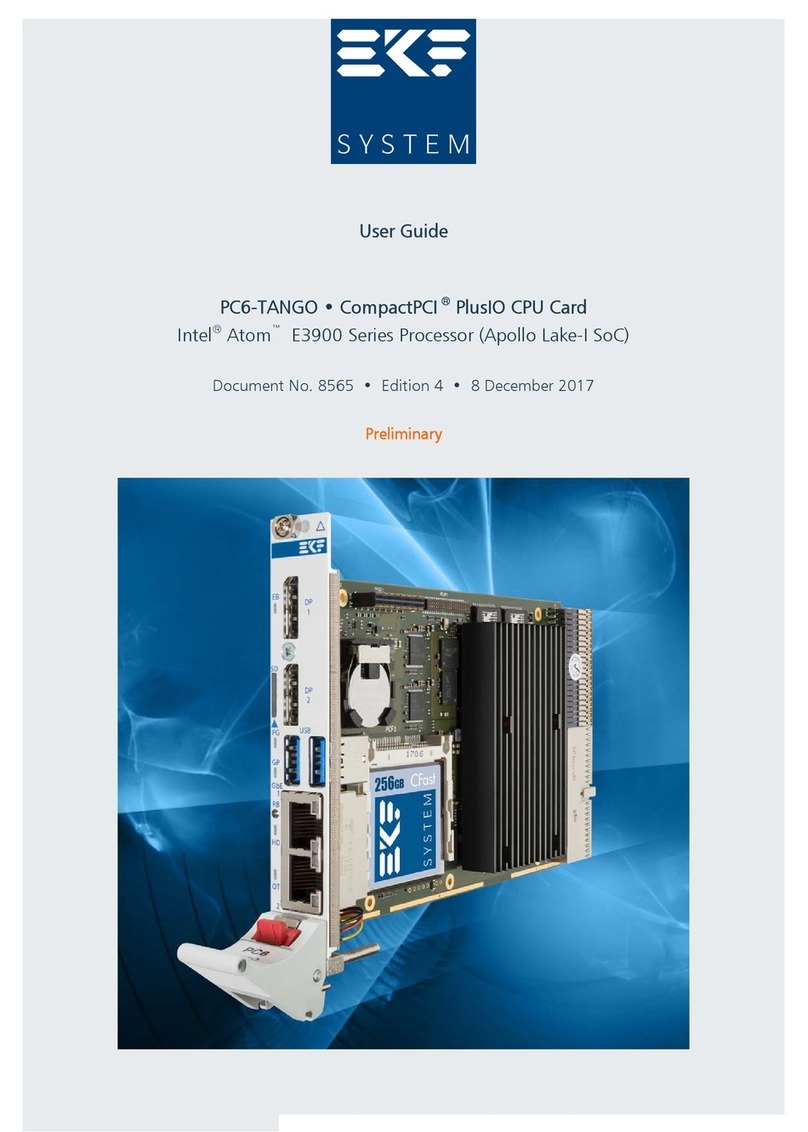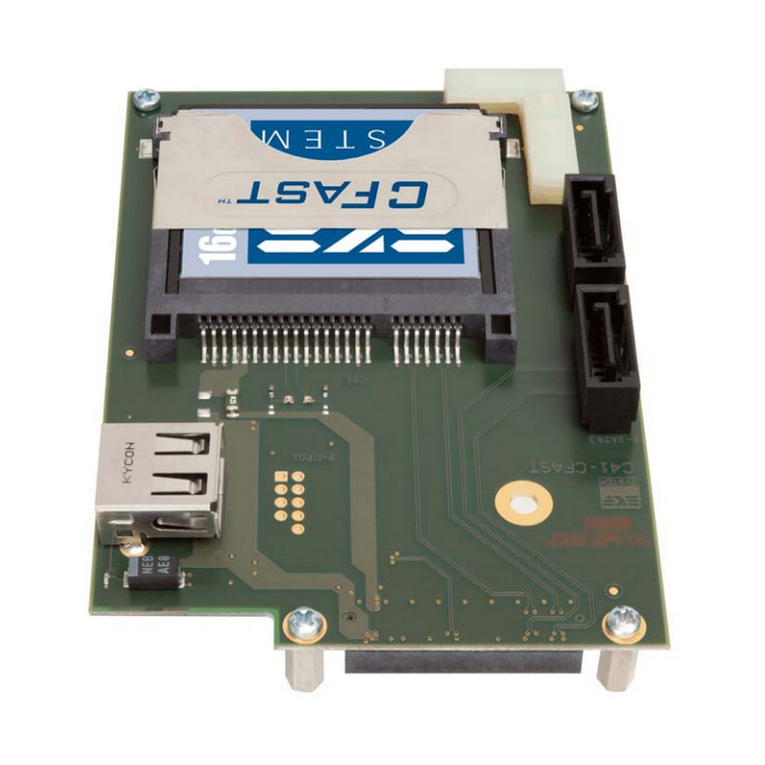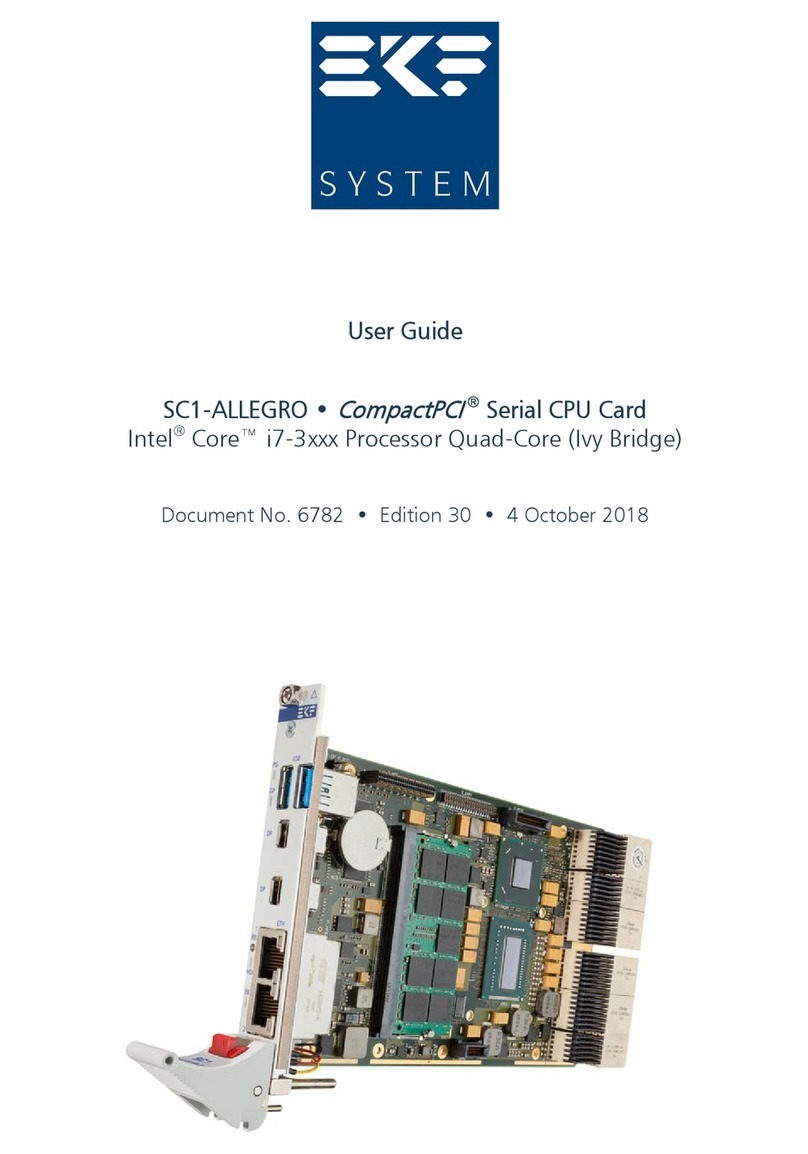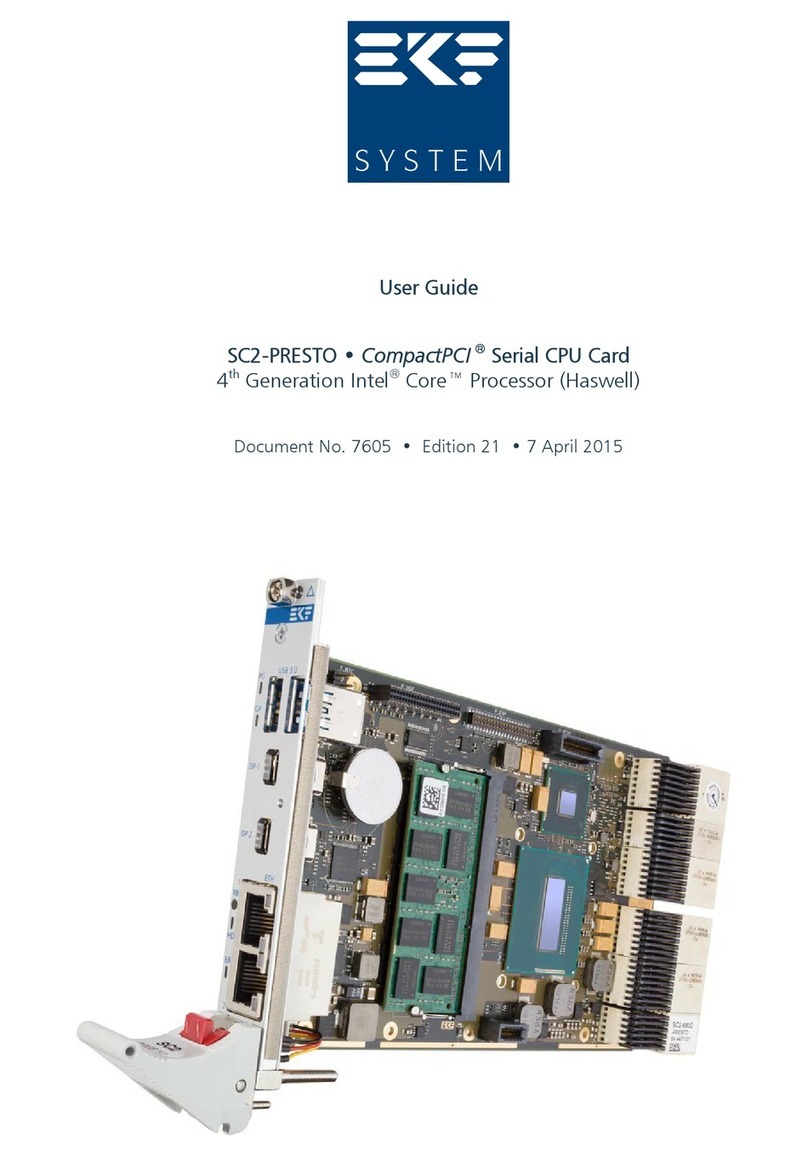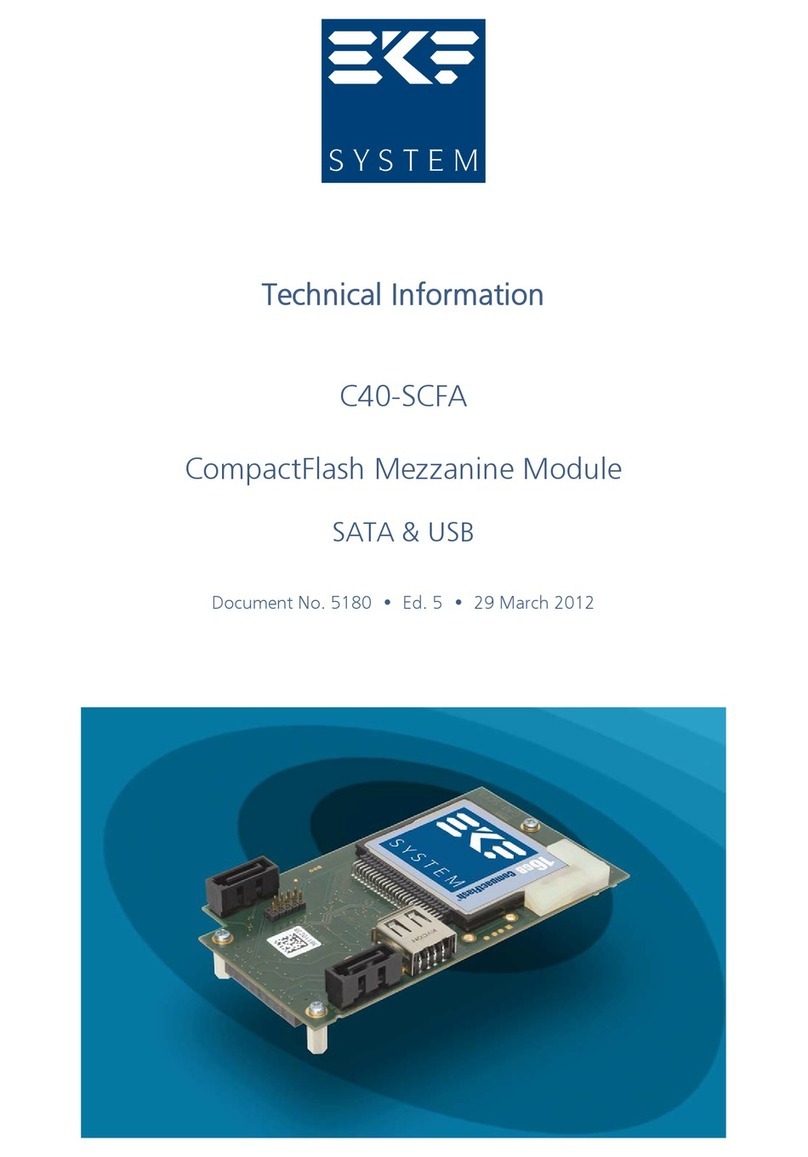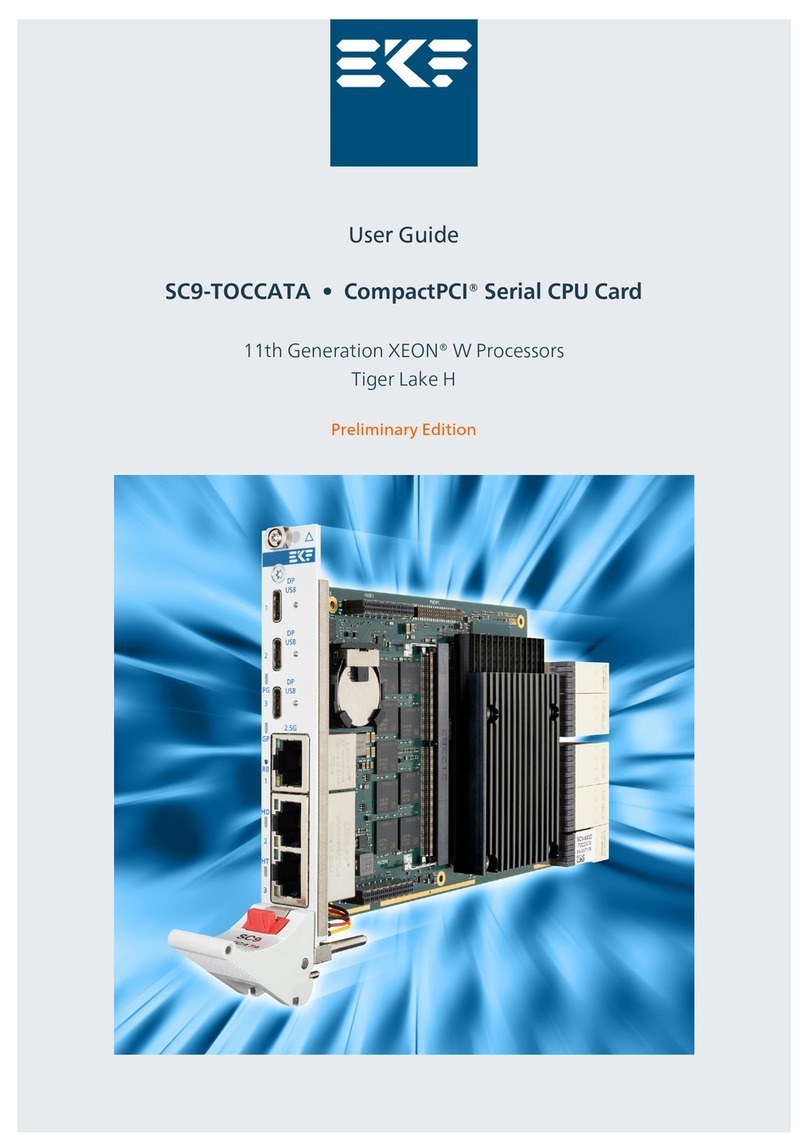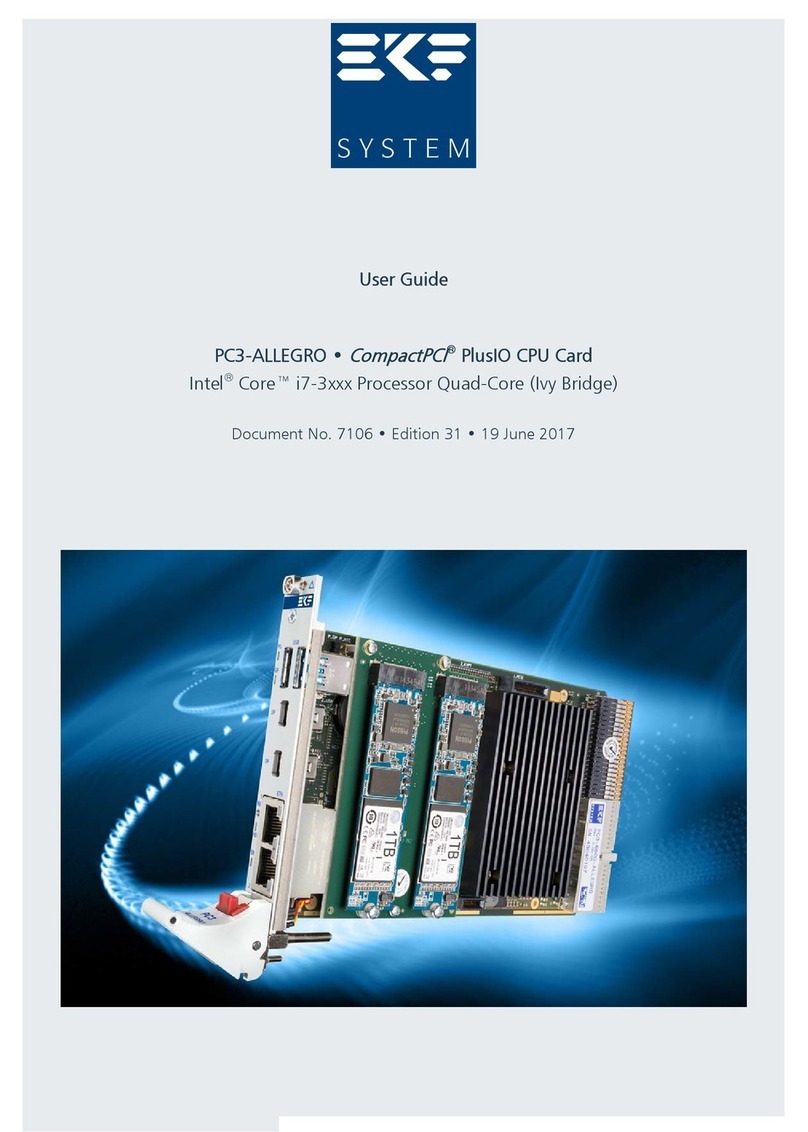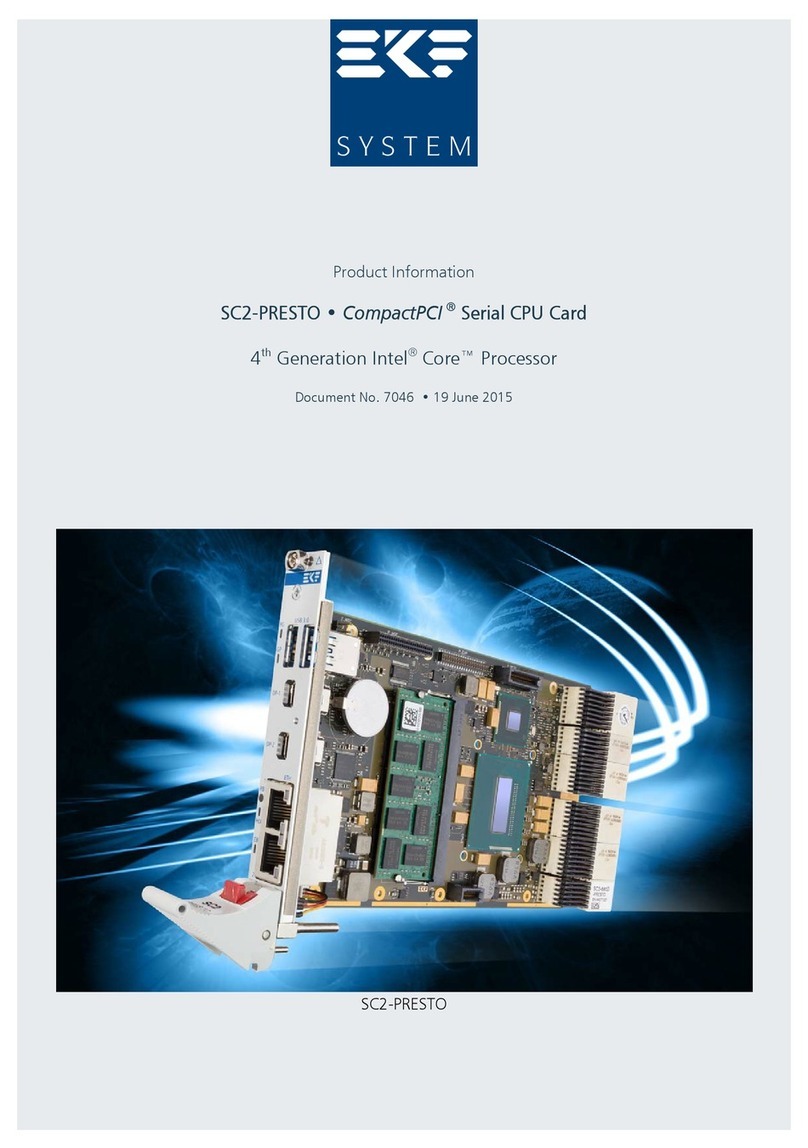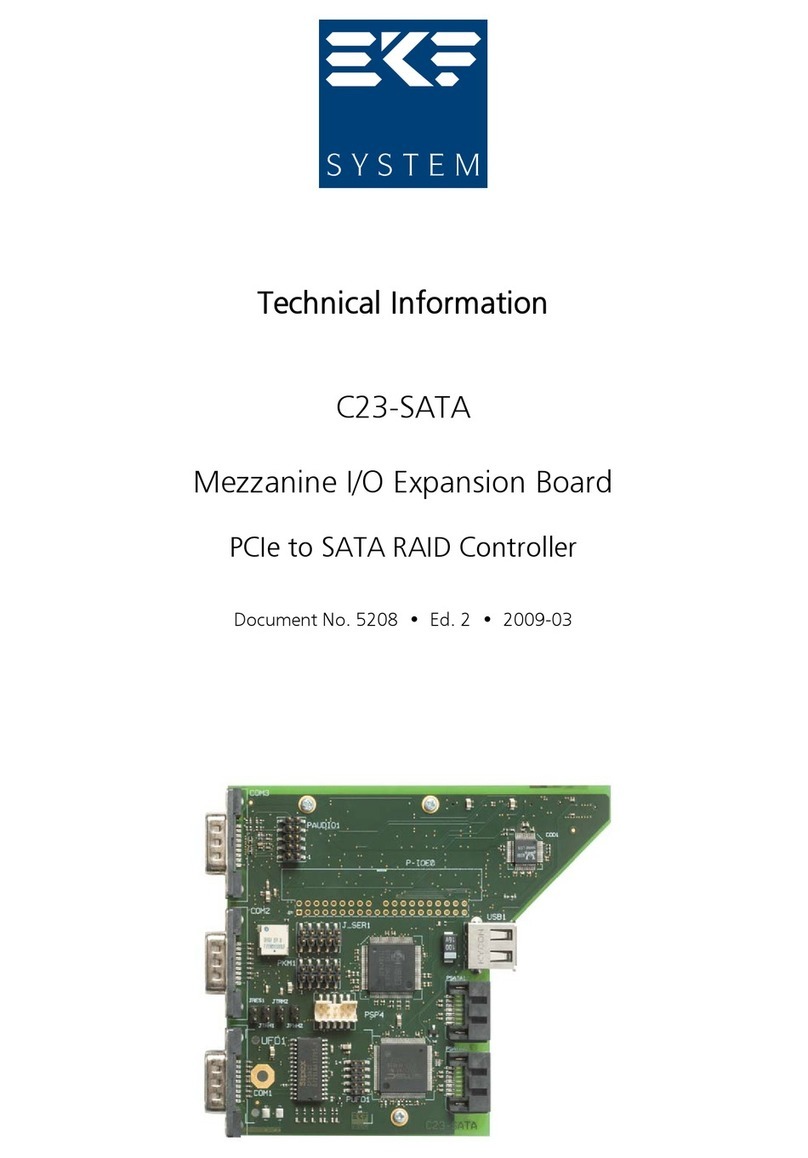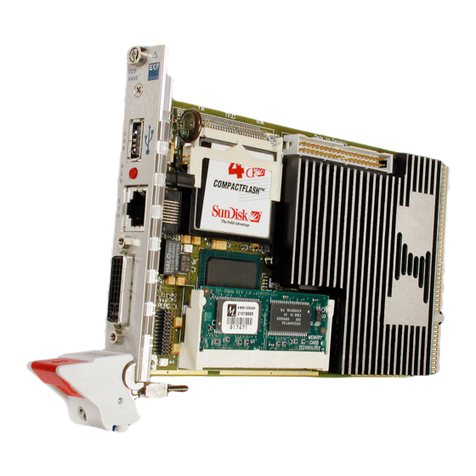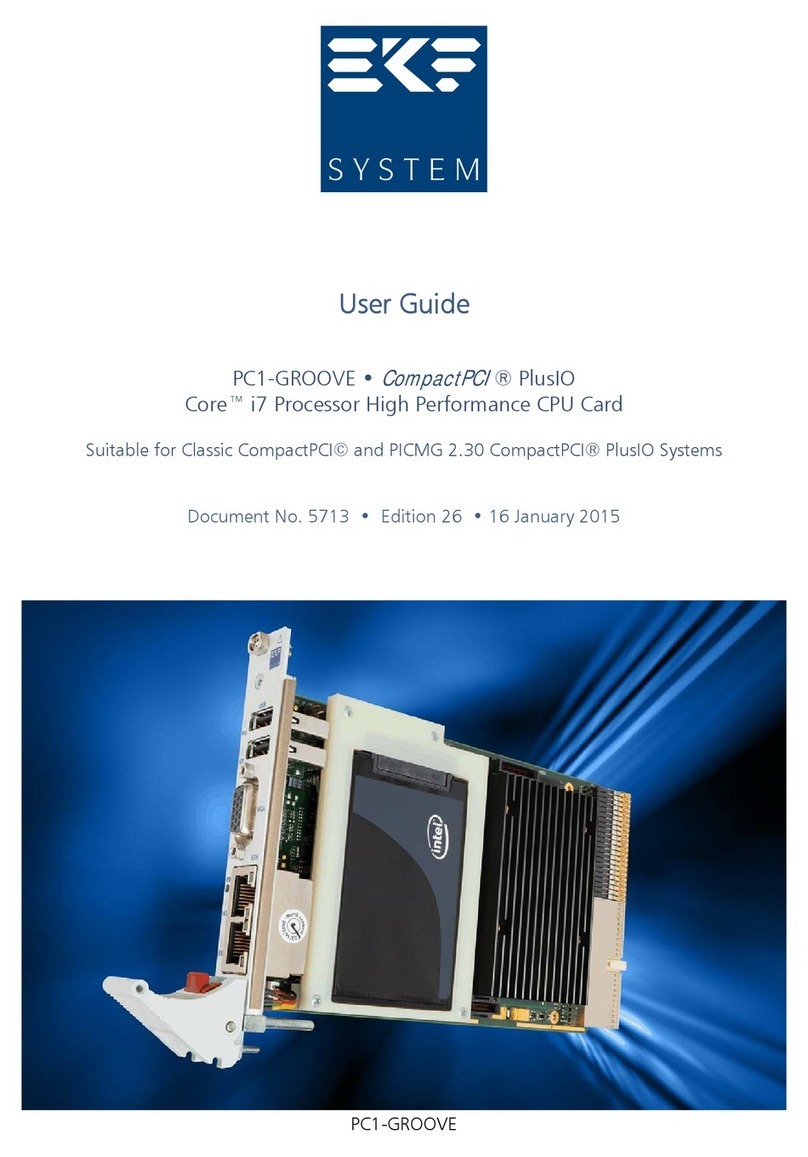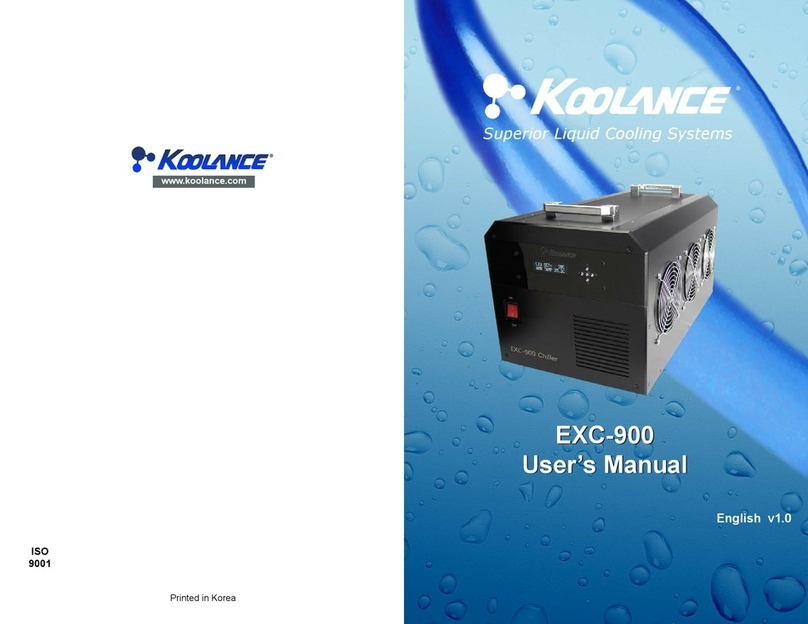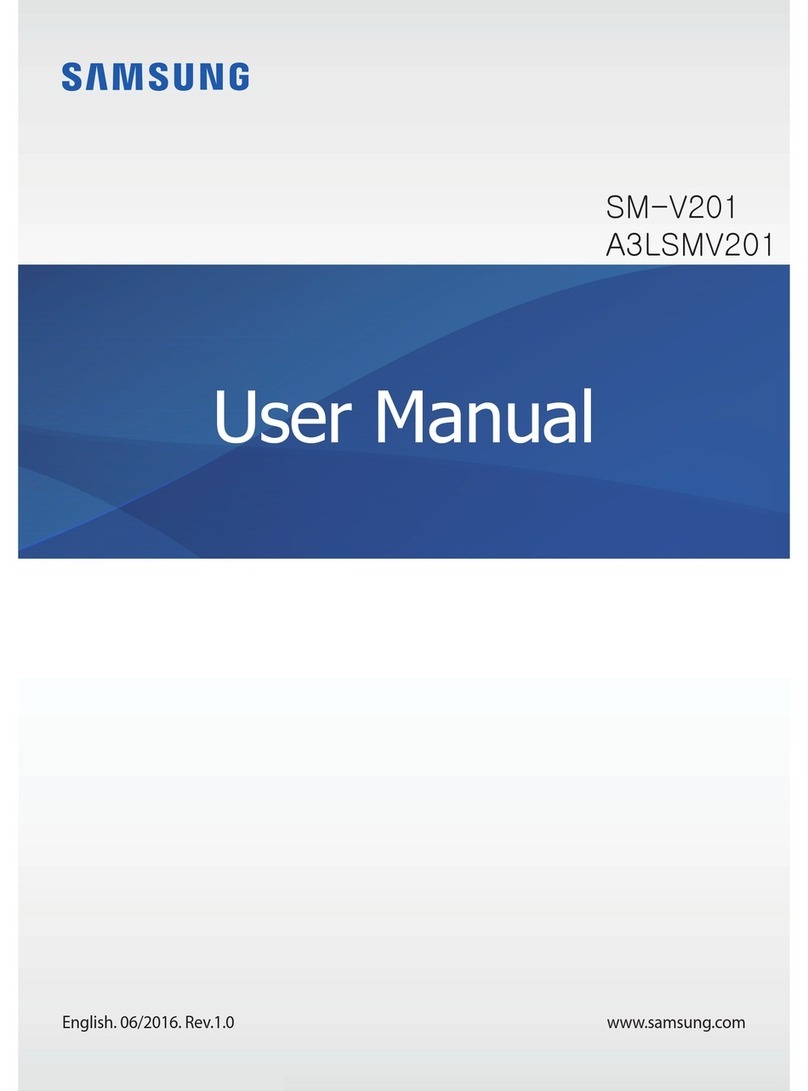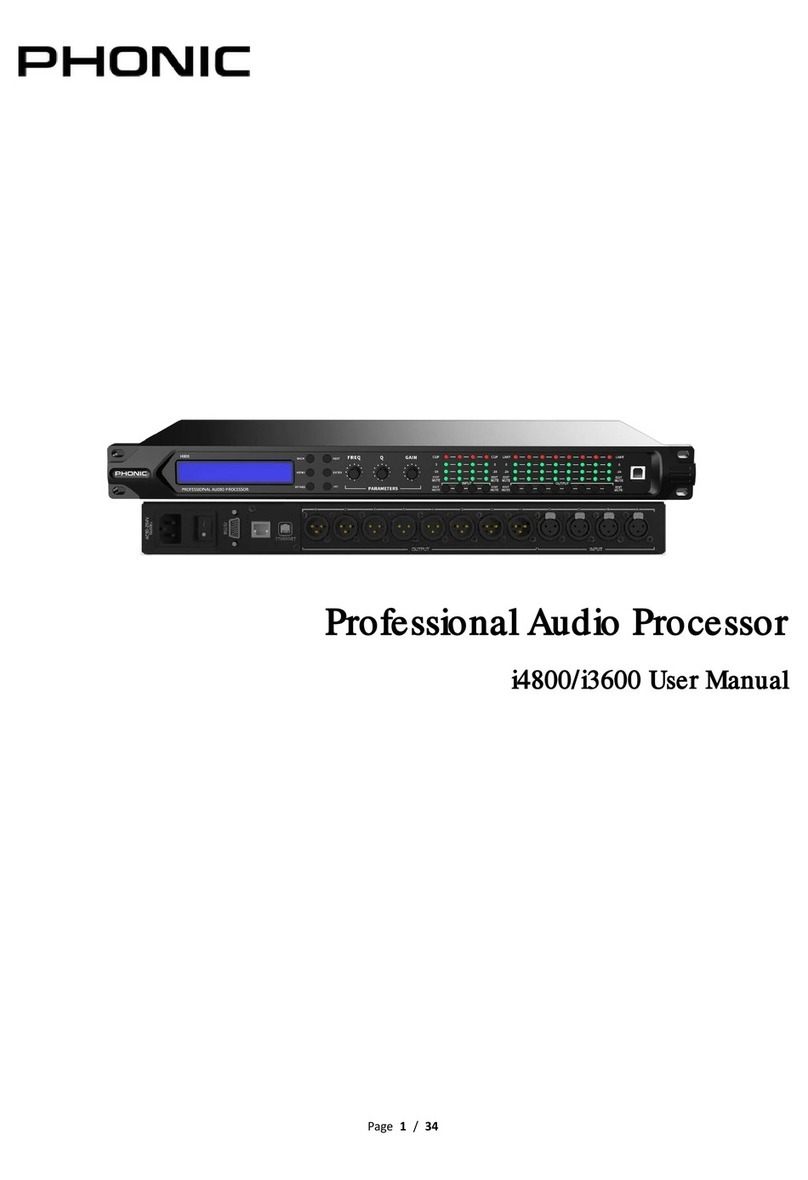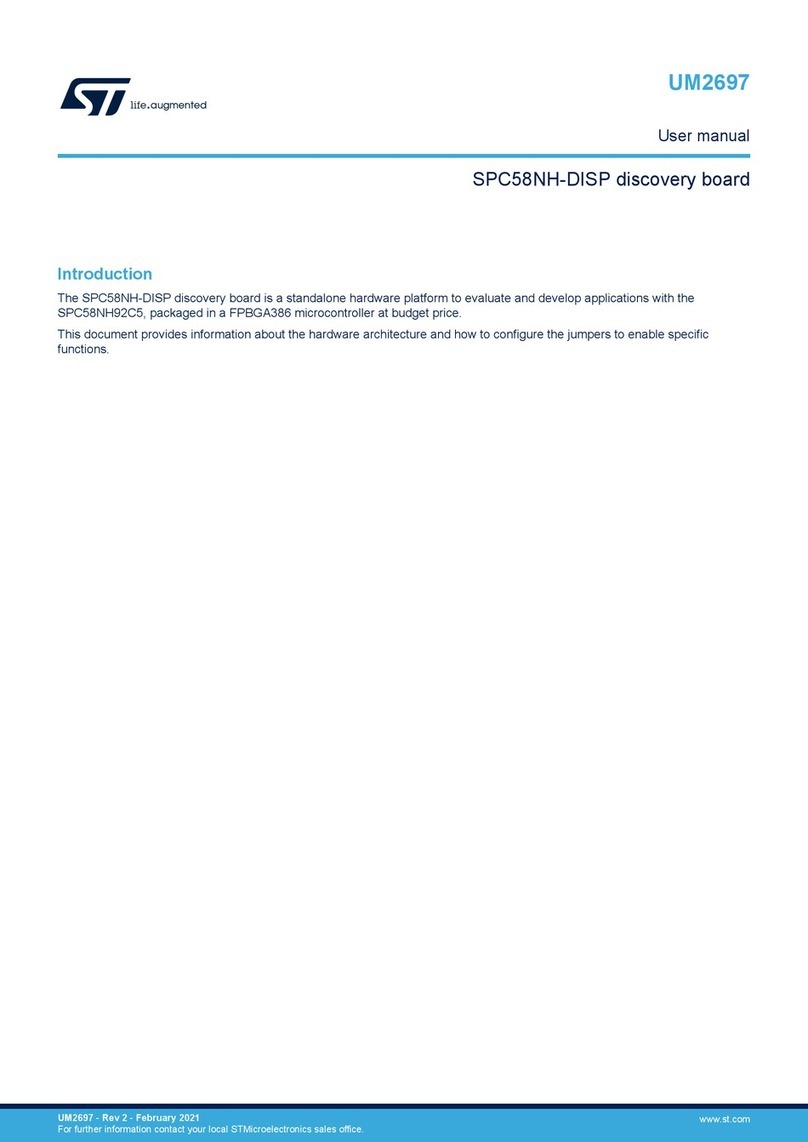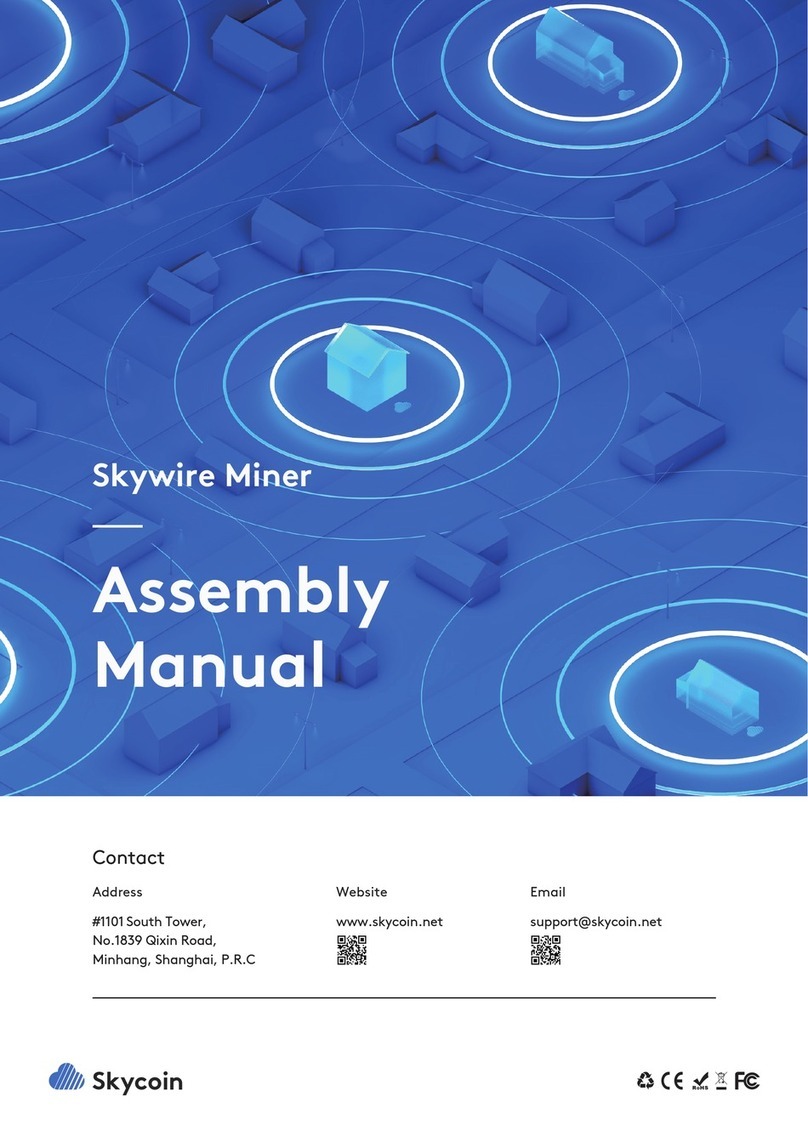EKF CompactPCI CCM-BOOGIE User manual

MEsstechnik fängt mit ME an.
Produkt-Datenblatt
Technische Daten, Spezifikationen
www.meilhaus.com
Erwähnte Firmen- und Produktnamen sind zum Teil
eingetragene Warenzeichen der jeweiligen Hersteller.
Preise in Euro zzgl. gesetzl. MwSt. Irrtum und Änderung
vorbehalten.
© Meilhaus Electronic bzw. Hersteller.
www.meilhaus.de/infos/impressum.htm
Kontakt
Technischer und kaufmännischer Vertrieb, Preis-
auskünfte, Angebote, Test-Geräte, Beratung vor Ort:
Tel: (0 81 41) 52 71-0
FAX: (0 81 41) 52 71-129
Aus dem Ausland:
Tel: ++49 - 81 41 - 52 71-0
FAX: ++49 - 81 41 - 52 71-129
Internet:
www.meilhaus.com
Web-Shop:
www.MEsstechnik24.de | www.MEasurement24.com
Web Kontakt-Formular:
www.meilhaus.de/infos/Kontakt.htm
Per Post:
Meilhaus Electronic GmbH
Am Sonnenlicht 2
D-82239 Alling bei München

User Guide
CCM-BOOGIE •
CompactPCI
®
3U High Performance CoreTM 2 Duo CPU Board
Document No. 5292 • Edition 19 • 4 May 2012
CCM-BOOGIE

User Guide CCM-BOOGIE • High Performance CoreTM 2 Duo 3U CompactPCI®CPU Board
© EKF -2- ekf.com
Contents
AboutthisManual ........................................................... 4
EditionHistory......................................................... 4
RelatedDocuments ..................................................... 5
Nomenclature ......................................................... 5
TradeMarks .......................................................... 5
Legal Disclaimer - Liability Exclusion ......................................... 5
Standards ............................................................ 6
CCM-BOOGIEFeatures ........................................................ 7
FeatureSummary ...................................................... 7
ShortDescriptionCCM-BOOGIE........................................... 11
BlockDiagramCCM-BOOGIE ............................................. 12
Top/BottomViewComponentAssembly .................................... 13
RearI/OTransitionModuleCCT-RIO........................................ 15
Strapping Headers ..................................................... 17
Connectors & Sockets .................................................. 17
FrontPanelElements ................................................... 17
Microprocessor ....................................................... 18
ThermalConsiderations ................................................. 19
MainMemory ........................................................ 20
LANSubsystem ....................................................... 21
SerialATAInterface(SATA) .............................................. 21
GraphicsSubsystem ................................................... 22
Real-TimeClock....................................................... 23
UniversalSerialBus(USB) ............................................... 23
LPCSuper-I/OInterface ................................................. 23
SPIFlash ............................................................ 23
Reset............................................................... 24
Watchdog........................................................... 26
PG(PowerGood)LED .................................................. 27
HD(HardDiskActivity)LED .............................................. 27
GP(GeneralPurpose)LED ............................................... 27
Hot Swap Detection ................................................... 28
PowerSupplyStatus(DEG#,FAL#) ........................................ 28
PXITriggerSignals..................................................... 28
MezzanineSideBoardOptions ........................................... 29
RearI/OOptions ...................................................... 47
InstallingandReplacingComponents............................................ 48
BeforeYouBegin...................................................... 48
InstallingtheBoard .................................................... 49
RemovingtheBoard ................................................... 50
EMCRecommendations................................................. 51
InstallingorReplacingtheMemoryModule .................................. 52
ReplacementoftheBattery .............................................. 52
TechnicalReference ......................................................... 53
LocalPCIDevices ...................................................... 53
LocalSMBDevices ..................................................... 54
Hardware Monitor LM87 ................................................ 55
GPIOUsage.......................................................... 56

User Guide CCM-BOOGIE • High Performance CoreTM 2 Duo 3U CompactPCI®CPU Board
© EKF -3- ekf.com
GPIOUsageICH9 ................................................ 56
GPIOUsageSIO ................................................. 58
ConfigurationJumpers ................................................. 59
ResetJumperBIOSCMOSRAMValues(P_GP) ........................... 59
ResetJumperICH9RTCCore(P_RTC) ................................. 59
Connectors .......................................................... 60
Front Panel Connectors ............................................ 60
Video Monitor Connector J_DVI ................................ 61
Video Monitor Connector J_VGA ............................... 62
USB Connectors ............................................ 63
Ethernet Connectors ........................................ 64
Internal Connectors .............................................. 65
ExpansionInterfaceHeaderJ_EXP .............................. 65
High Speed Expansion Connector J_HSE .......................... 66
PCIExpressExpansionHeaderJ_PCIE ............................ 68
SDVOExpansionHeaderJ_SDVO ............................... 69
SystemResetHeaderP_RST ................................... 69
PLDProgrammingHeaderP_ISP ................................ 70
ProcessorDebugHeaderXDP1................................. 70
CompactPCI J1............................................. 71
CompactPCI J2............................................. 72
Appendix ................................................................. 74
MechanicalDrawings .................................................. 74

User Guide CCM-BOOGIE • High Performance CoreTM 2 Duo 3U CompactPCI®CPU Board
© EKF -4- ekf.com
About this Manual
This manual describes the technical aspects of the CCM-BOOGIE, required for installation and system
integration. It is intended for the experienced user only.
Edition History
Ed. Contents/Changes Author Date
1 User Manual CCM-BOOGIE, english, initial edition (Text #5292, File:
ccm_uge.wpd)
gn 2008-10-27
2 Added 'Top View Component Assembly' diagram, changed 'Mechanical
Drawings', changed LPC bridge device ID in table 'Local PCI Devices',
removed section 'Mass Storage Considerations'.
gn 2008-11-07
3 Added chapter ‘Mezzanine Side Board Options’ jj 11 November 2008
4 Added Images CCM-BOOGIE, Mezzanine Stack jj 5 January 2009
5 Replaced DVI connector illustration, replaced C44-SATA illustration,
table 'Literature' updated and moved to table 'Standards', minor
changes throughout text/tables reflecting C42-SATA and
CCO-CONCERT
jj 19 February 2009
6 Corrected SMBus Address of ADT7421.
Corrected typo within CompactPCI J2 connection table.
Added PCIe-SATA-Bridge JMB362 to local PCI devices table.
gn 2009-03-17
7 Added power requirements and performance rating for CCM-6 to table
‘Feature Summary’. Added some images and illustrations of mezzanine
modules and side cards.
gn 2009-09-01
8 Added power requirements for sleep states S3 S4 S5 jj 3 September 2009
9 Added photo CCM bottom view jj 24 September 2009
10 Added photo CCT custom specific version, added photos CCG-CCK-DX1
exploded view, added photo CR4
jj 17 November 2009
11 CCH-MARIACHI side card replaced by CCO-CONCERT jj 19 February 2010
12 Added to table Feature Summary: +3.3V V(I/O) option jj 5 November 2010
13 Parallel ATA drives on side cards not supported jj 1 March 2011
14 Added description of unlocked front panel handle signalling gn 2011-04-13
15 Added photos showing how to force system shutdown using the front
panel handle integrated switch, added photos 'Small Systems' and
'Rugged Systems'
jj 13 May 2011
16 BIOS usage of GP LED - link added jj 18 May 2011
17 Highlighted BIOS GP LED Usage Link gn 2011-06-17
18 Added photos of several mezzanine storage modules jj 23 August 2011
19 Added MTBF value to table Feature Summary gn 2012-05-04

User Guide CCM-BOOGIE • High Performance CoreTM 2 Duo 3U CompactPCI®CPU Board
© EKF -5- ekf.com
Related Documents
For ordering information refer to document CCM-BOOGIE Product Information, available at
www.ekf.com/c/ccpu/ccm/ccm_pie.pdf.
Other documents related to the CCM-BOOGIE - in particular technical information of suitable
mezzanine side boards - can be found at www.ekf.com/c/ccpu/ccm/ccm_e.html.
Nomenclature
Signal names used herein with an attached '#' designate active low lines.
Trade Marks
Some terms used herein are property of their respective owners, e.g.
<Pentium, Pentium M, Celeron M, Core 2 Duo, Penryn, Cantiga GS45, Montevina Platform,
Boazman, Fern Hill CRB, iAMT: ® Intel
<
CompactPCI
: ® PICMG
<Windows 2000, Windows XP, Windows Vista: ® Microsoft
<EKF, ekf system: ® EKF
EKF does not claim this list to be complete.
Legal Disclaimer - Liability Exclusion
This manual has been edited as carefully as possible. We apologize for any potential mistake.
Information provided herein is designated exclusively to the proficient user (system integrator,
engineer). EKF can accept no responsibility for any damage caused by the use of this manual.

User Guide CCM-BOOGIE • High Performance CoreTM 2 Duo 3U CompactPCI®CPU Board
© EKF -6- ekf.com
Standards
Theme Document Title Origin
CompactFlash CF+ and CompactFlash Specification Revision 3.0 www.compactflash.org
CompactPCI CompactPCI Specification, PICMG 2.0 R3.0, Oct. 1,
1999
www.picmg.org
DVI Digital Visual Interface Rev. 1.0
Digital Display Working Group
www.ddwg.org
Ethernet IEEE Std 802.3, 2000 Edition standards.ieee.org
HD Audio High Definition Audio Specification Rev.1.0 www.intel.com/design/chipsets/hdaudio.htm
PCI Express PCI Express®Base Specification 1.1 www.pcisig.com
PCI Local Bus PCI 2.2/2.3/3.0 Standards PCI SIG www.pcisig.com
SATA Serial ATA 2.5/2.6 Specification www.sata-io.org
TPM Trusted Platform Module 1.2 https://www.trustedcomputinggroup.org
USB Universal Serial Bus Specification www.usb.org

User Guide CCM-BOOGIE • High Performance CoreTM 2 Duo 3U CompactPCI®CPU Board
© EKF -7- ekf.com
CCM-BOOGIE Features
Feature Summary
Feature Summary CCM-BOOGIE
Form Factor Single size CompactPCI style Eurocard (160x100mm2), front panel width 4HP (20.3mm)
Processor Designed for Intel® Core™ 2 Duo SFF (Small Form Factor) processors (codename Penryn),
1066/800MHz FSB, maximum junction temperature 105°C, Enhanced Intel® Speedstep®
Technology 1, Dual Core Multiprocessing 1, Intel® Virtualization Technology (VT) 1, Intel® 64
Architecture
<Core™ 2 SV • SP9300 • 2.26GHz • FSB 1066MHz • 6MB L2 Cache • 25W TDP
<Core™ 2 LV • SL9400 • 1.86GHz • FSB 1066MHz • 6MB L2 Cache • 17W TDP
<Core™ 2 ULV • SU9300 • 1.2GHz • FSB 800MHz • 3MB L2 Cache • 10W TDP
<Celeron® M ULV • 722 • 1.2GHz • FSB 800MHz • 1MB L2 Cache • 5.5W TDP
1features not available with Celeron® M ULV 722 processor
Chipset Mobile Intel® 45 (Codename Cantiga) chipset comprised of:
<GS45 Graphics/Memory Controller Hub (GMCH) with Intel® Gen. 5.0 integrated
graphics engine with 10 fully-programmable cores, 1600x1200 dual independent
display, HW support for H.264, MPEG2, VC-1, improved 3D capability (DirectX
10/OpenGL 2.0 support), estimated 533-MHz core render clock (low-power mode
266MHz), iAMT manageability engine, option Integrated Trusted Platform Module
(ITPM)
<ICH9M-E Enhanced I/O Controller Hub, integrated GbE MAC, 12 x USB (2 x EHCI, 6 x
UHCI cntrls.), 4 x SATA 3Gbps, Intel® Matrix Storage Technology (RAID 0, 1, 5, 10),
iAMT, High Definition Audio, unified SPI Flash support
Memory (RAM) <Maximum memory capacity of 8GB DDR3 up to 1066MHz
<512Mb, 1Gb, 2Gb, [4Gb] technologies for x8 and x16 devices
<Channel 0 populated as directly soldered DDR3 devices (Memory Down)
<Channel 1 provided as 204-pin SODIMM socket to carry DDR3 module PC3-8500
<Dual channel symmetric – memory addresses interleaved for increased performance
(SODIMM module size must match Memory Down size)
<Intel® Flex Memory Technology (dual channel interleaved mode with unequal memory
population) - memory sizes maybe unequal in both the channels
<Dual channel asymmetric – memory sizes may differ, including no memory module
populated in the SODIMM socket (single-channel)
Non Volatile
Memory (NVM)
<Intel® Turbo Memory card (codename Robson) on CCI-RAP mezzanine side board
optionally available
<PCI Express Mini Card 1G Byte Flash
<Microsoft® ReadyDrive and ReadyBoost (Windows® Vista)
<Intel® Turbo Memory driver
Video <Both (concurrently) analog monitor and digital flat-panel display support by DVI-I
connector (front panel), up to 2048x1536 pixel 16M colours @75Hz refresh rate
(analog), up to 1600 x 1200 pixel 16M colours @60Hz (digital), incorporates
PanelLink Digital technology (Silicon Image)
<Dual screen capable 2 x 1600 x 1200 pixel (one display attached to the front panel,
the other to the back panel, or both to the front panel by means of a DVI-I to DVI-
D/VGA splitter cable, or secondary DVI-D connector on mezzanine side board)
<Front panel option: D-Sub (female HD15) VGA connector available, replaces DVI-I
connector
<Rear I/O option: Analog video output configurable (BIOS) across J2/P2 CCT-RIO rear I/O
transition module
<Mezzanine option: Secondary DVI-D connector at mezzanine card front panel allows
for dual digital flat panel operation, suitable mezzanine modules e.g. CCH-MARIACHI,
CCI-RAP, CCJ-RHYTHM, CCO-CONCERT

User Guide CCM-BOOGIE • High Performance CoreTM 2 Duo 3U CompactPCI®CPU Board
Feature Summary CCM-BOOGIE
© EKF -8- ekf.com
USB <All ports over-current protected, data transfer rate of up to 480Mbps, conforming to
USB2.0
<2 x USB type A connector (front panel)
<3 x USB ports J2/P2 Rear I/O option (CCT-RIO rear I/O transition module)
<2 x USB ports via J-EXP expansion interface option (in use by several mezzanine side
boards)
<4 x USB ports via J-HSE (C40-SCFA mezzanine storage module)
<Dual EHCI / six UHCI controllers provided by ICH9M-E
Ethernet <Two 10/100/1000Mbps Gigabit Ethernet controllers, accessible via RJ45 jacks from the
front panel
<ETH1 equipped with Intel® 82567LM PHY (codename Boazman), serves also as AMT
out of band communication path (MAC provided by ICH9M-E), Jumbo Frame support
up to 9KB
<ETH2 equipped with Intel® 82574L GbE controller (codename Hartwell), connected to
local PCIe lane, supports 9018-byte jumbo packets, TimeSync Offload compliant with
802.1as specification
<Option ETH1 Gigabit Ethernet configurable (BIOS setup) across J2/P2 with attached
CCT-RIO rear I/O transition module
SATA <Total of six 3Gbps SATA channels available
<Triple-channel Serial ATA 3Gbps available for J2/P2 rear I/O option (derived from ICH9)
<Suitable rear I/O transition module CCT-RIO (2 x system internal SATA, 1 x eSATA for
attachment of external devices)
<Intel® Matrix Storage Technology MST (Raid 1, 0, Matrix Raid)
<Secondary on-board PCIe to SATA controller JMB362, dual channel SATA RAID,
available via J-HSE expansion connector (plus 1 SATA channel in addition from ICH9)
<Additional PCIe to SATA controller on mezzanine side boards e.g. CCI-RAP,
CCK-MARIMBA, CCL-CAPELLA, CCO-CONCERT
PATA (IDE) <Option mezzanine module attached to J-HSE expansion connector
<C40-SCFA mezzanine module available with on-board SATA to PATA bridge and
CompactFlash socket
PCI Express <4-Lane PCIe high-speed connector J-PCIE for CCJ-RHYTHM and other mezzanine
expansion cards (side boards)
<Possible configurations 1 Link x 4 Lanes, 4 Links x 1 Lane
Mezzanine
Side Board
I/O
<J-EXP Legacy expansion interface connector LPC/USB/Audio (SIO, USB, HD Audio)
<J-HSE High-speed expansion interface connector (3 x SATA, 4 x USB)
<J-PCIE PCI Express 4-lane high-speed expansion connector
<J-SDVO secondary digital graphics port high-speed expansion connector
<Suitable mezzanine companion side boards available, e.g.:
<CCI-RAP: 2 x PCI Express Mini Card sockets (WLAN, GSM, Wimax, Intel®
Turbo Memory), options secondary DVI-D, IEEE 1394 (FireWire), USB SSD,
C20-SATA mezzanine storage module (accommodates up to 2 SATA hard disk
drives 2.5-inch RAID capable)
<CCJ-RHYTHM: CompactPCI Express system slot controller function by on
board 6-port 24-lane PCIe switch, options DVI-D, IEEE 1394 (FireWire)
<CCK-MARIMBA: PMC/XMC module carrier, option C20-SATA mezzanine
storage module
<CCL-CAPELLA: Up to 4 Gigabit Ethernet ports, options IEEE 1394 (FireWire),
USB SSD, C20-SATA mezzanine module
<CCO-CONCERT: Audio analog/digital, option secondary DVI-D
<C23-SATA: PCIe to 2 x SATA 1 x PATA controller
<C40-SCFA: SATA to PATA bridge & CompactFlash header, option USB SSD,
4HP envelope maintained
<C41-CFAST: CFast™ Flash card header, 4HP envelope maintained
<C42-SATA: 1.8-inch SATA Solid State Drive (SSD), 4HP envelope maintained

User Guide CCM-BOOGIE • High Performance CoreTM 2 Duo 3U CompactPCI®CPU Board
Feature Summary CCM-BOOGIE
© EKF -9- ekf.com
J2
Rear I/O
<Suitable rear I/O transition module CCT-RIO available
<3 x Serial ATA (SATA), 2 x system internal SATA connectors, 1 x external eSATA
connector
<1 x Gbit Ethernet (switched by BIOS between front panel I/O and rear I/O)
<3 x USB
<VGA Analog Video (switched by BIOS between front panel I/O and rear I/O)
<PS/2 Keyboard, Mouse
<COM port (TTL Level)
J1
CompactPCI®
<ICH9M-E integrated 32-bit PCI bridge, 33MHz 133MBps CPCI master
<Additional PCI arbiter in PLD for fully figured 8-slot CompactPCI backplane
<+5V V(I/O) default configuration (PCI pull-up resistors 1k - blue coding key on J1)
<+3.3V V(I/O) on request (PCI pull-up resistors 2.7k - yellow coding key on J1)
CompactPCI®
Express
<CCM-BOOGIE can be configured as CompactPCI Express System Board (system slot
controller) by optionally available mezzanine expansion card (side board) CCJ-RHYTHM
<CPCIe 4-Link configuration (4-lanes each), for up to 4 CPCIe peripheral slots type 1
and/or type 2 on a passive CPCIe backplane
<Suitable also for hybrid CPCI/CPCIe systems/backplanes (e.g. Schroff)
CompactPCI®
Serial
<CCM-BOOGIE can be configured as CompactPCI Serial System Board (system slot
controller) by optionally available mezzanine expansion card (side board) SJ1-JAM
<Suitable for hybrid CompactPCI and CompactPCI Serial systems/backplanes
Platform
Management
(on Request)
<Hardware is ready for AMT 4.0 Intel® Active Management Technology (iAMT)
<ARM core based Manageability Engine (ME) in the GMCH
<Independent manageability firmware, to be stored in SPI Flash
<No iAMT BIOS support available as of current
Secure
Computing
<Option Trusted Platform Module TPM 1.2 according to Trusted Computing Group
specifications
<Choose from either integrated solution (GS45 Intel® Trusted Execution Technology),
or available as discrete controller on several mezzanine boards e.g. CCH/CCI/CCJ
<Discrete crypto engine silicon brands Infineon or Atmel at users choice
BIOS <Phoenix BIOS with EKF enhancements for embedded systems
<SPI Flash memory 2 x 16/32/64 Mb
<Updates available from website ekf.com
Drivers
(All Major OS)
<Intel® graphics driver, Intel® embedded graphics driver
<Intel® networking driver
<Intel® Matrix Storage Manager software
<Intel® Turbo Memory driver
<JMicron SATA driver
Thermal
Conditions
Environmental
Conditions
<Operating temperature: 0°C ... +70°C (CPU dependent)
<Storage temperature: -40°C ... +85°C, max. gradient 5°C/min
<Humidity 5% ... 95% RH non condensing
<Altitude -300m ... +3000m
<Shock 15g 0.33ms, 6g 6ms
<Vibration 1g 5-2000Hz
EC Regulations <EN55022, EN55024, EN60950-1 (UL60950-1/IEC60950-1)
<2002/95/EC (RoHS)
MTBF 141 x 103h (16 years) @ 50° C

User Guide CCM-BOOGIE • High Performance CoreTM 2 Duo 3U CompactPCI®CPU Board
© EKF -10- ekf.com
Typical Power
Requirements
1) Intel®
SpeedStep®
Frequency Modes
LFM: Low
Frequency Mode,
HFM: High
Frequency Mode
2) Add per Ethernet
port 0.4/1.2A (link
only/active)
@1Gbps or
0.1/0.4A @
100Mbps
Board
+3.3V +0.17V/-0.1V +5V +0.25V/-0.15V
MaxPower
LFM/HFM 1)
WinXP Idle
LFM/HFM 1)
MaxPower
LFM/HFM 1)
WinXP Idle
LFM/HFM 1)
CCM-6-BOOGIE
5.1/5.2A 2) 2.1/2.1A 2) 2.3/4.5A 0.3/0.5A
S3: 200mA
S4: 100mA
S5: 100mA
S3: 50mA
S4: 50mA
S5: 30mA
Performance
Rating
Measured with
PCMark2005
under Windows
XP, 2 x 2GB
DDR3 1066
Board Processor CPU/MEM Score
CCM-6-BOOGIE SP9300 5650
CCM-4-BOOGIE SL9400
CCM-2-BOOGIE SU9300
Table items are subject to technical changes

User Guide CCM-BOOGIE • High Performance CoreTM 2 Duo 3U CompactPCI®CPU Board
© EKF -11- ekf.com
Short Description CCM-BOOGIE
The CCM-BOOGIE is a versatile 4HP/3U
CompactPCI
®
CPU board, equipped with an
Intel® Core™ 2 Duo processor at up to
2.26GHz clock, and up to 8GB dual channel
capable DDR3 RAM. Four native 3Gbps RAID
capable Serial ATA channels are available for
mass storage I/O, and in addition another two
from a secondary RAID controller. The
CCM-BOOGIE has been designed especially for
systems which require dual core high
performance at moderate power consumption.
The CCM-BOOGIE is provided with a high
performance mobile chipset (Intel® GS45)
which operates at up to 1066MHz FSB and up
to 1066MHz DDR3 memory clock for optimum
system throughput. The chipset is based on PCI
Express® technology and has a powerful
integrated graphics accelerator. The DVI-I front
panel connector enables dual screen video
operation. Two Gigabit Ethernet controllers are
provided for high speed connectivity (one of
them IEEE 802.1as TimeSync compliant).
The CCM-BOOGIE is equipped wit a set of local
expansion interface connectors, which can be
optionally used to directly attach a suitable
(application specific) mezzanine side board, e.g.
for audio- and legacy support, PCI Express
based I/O circuitry, and a secondary DVI video
output. Carrier board and side card come as a
readily assembled 8HP unit typically. Most
mezzanine cards can accommodate in addition
a 2.5-inch drive. Also as an option, a suitable
rear I/O transition module is available to the
CCM-BOOGIE.
As a popular add-on option, the CCM-BOOGIE
can be delivered with a small mezzanine
module (C42-SATA), which accommodates a
1.8-inch SATA solid state drive (SSD).
Alternatively, the C40-SCFA mezzanine card is
provided with an industrial grade CompactFlash
memory card, and/or an even more rugged USB
Silicon State Drive (SSD). Both mezzanine
modules fit into the 4HP envelope of the entire
assembly.
Benefits of the CCM-BOOGIE
<High Performance CompactPCI® System Slot Controller with or w/o Rear I/O
<CompactPCI® Express System Board Option (CCJ-RHYTHM Mezzanine Expansion Card)
<Hybrid Systems Option (Dual Backplane CompactPCI® & CompactPCI® Express)
<Intel® Core™ 2 Duo SV (45nm Penryn) Mobile Processor 2.26GHz 6MB L2 Cache (FSB
1066MHz)
<Scalable Series of Small Form Factor (SFF) Processors from 1.2GHz to 2.26GHz
<PCI Express Mobile Intel® 45 Express Chipset GS45 (Cantiga)
<Up to 2 x 4GB DDR3 Memory (Dual Channel Mode Capable, up to 1066MHz)
<One Memory Bank Soldered (Memory Down) for Extreme Ruggedized Systems
<Dual-Screen Graphics Controller
<Dual Gigabit Ethernet Controllers
<Four Native SATA Channels 3Gbps, Intel®Matrix Raid Storage Technology
<Two Additional SATA Channels 3Gbps, RAID capable with JMicron Drivers
<Eleven USB 2.0 channels
<CompactFlash and/or USB SSD with C40-SCFA Mezzanine Module Option (4HP
Maintained)
<SATA SSD 1.8-Inch with C42-SATA Mezzanine Module Option (4HP Maintained)
<Variety of Mezzanine Expansion Boards Available with and w/o PCIe
<TPM 1.2 Option (on Mezzanine Expansion Board or GS45 Internally)
<Rear I/O Transition Module Option
<Intel® AMT 4.0 Platform Management
<RoHS compliant

User Guide CCM-BOOGIE • High Performance CoreTM 2 Duo 3U CompactPCI®CPU Board
© EKF -12- ekf.com
SPI
Flash
CompactPCI Rear I/O
Simplified Block Diagram
CCM-BOOGIE
J-EXPJ-PCIE
J-SDVO
Opt. Mezz.
Exp. Board
Opt. Mezz.
Expansion
Board
Opt.
Mezzanine
Storage
Module
DDR3 Soldered
DDR3 SO-DIMM
82
574L
82
567LM
Panel
Link
SATA II
RAID
SPI
Flash
isp
MACH
87
61
GbE
1
GbE
2
BIOS & FW
2 x 16/32Mb
Glue Logic
PCI Arbiter
PCI
7 x PCI
USB
PCIe
HD Audio
Gigabit
Ethernet
x 4 PCIe
iAMT Gb
Ethernet
iAMT
ME
iTPM
DDR3 800/1066
2GB/4GB/8GB
Dual Channel
J1
J2
LPC
Front Panel I/O
FSB
800/1066
GS45
GMCH
ICH9M-E
RAID
iAMT
J-HSE
Video
VGA
SIO
SPI
SATA
SATA
RAID
SATA
USB
Opt. Rear I/O
CCT-RIO
KB/MS
COM
GPIO
USB
USB
DVI2/
DisplayPort
Hartwell
Boazman
GLCI
Gb ETH
DMI x 4
VGA
SDVO1
Montevina
Penryn
Cantiga
SDVO2 PCIe
RGB
DVI1
top/
bottom
VGA
D-SUB
32bit/33MHz
Core™2
2.26GHz
6MB L2
4 x PCI
SP9300 Core™2 SV
SL9400
2.26GHz/FSB1066/6MB L2
SU9300 Core™2 ULV
722 Celeron® M ULV
1.2GHz/FSB800/3MB L2
1.2GHz/FSB800/1MB L2
Core™2 LV
1.86GHz/FSB1066/6MB L2
Block Diagram CCM-BOOGIE

User Guide CCM-BOOGIE • High Performance CoreTM 2 Duo 3U CompactPCI®CPU Board
© EKF -13- ekf.com
Top/Bottom View Component Assembly
© EKF ekf.com
CCM-BOOGIE
DDR3 SO-DIMM
GMCH
GS45
Dual
GB-Ethernet
DVI-I / VGA
Core™ 2
CPU
ICH9M
-E
DDR3 Soldered
NIC1
NIC2
USB
J-HSE J-EXP J-PCIE
J-SDVO
USB

User Guide CCM-BOOGIE • High Performance CoreTM 2 Duo 3U CompactPCI®CPU Board
© EKF -14- ekf.com
Bottom View CCM-BOOGIE

User Guide CCM-BOOGIE • High Performance CoreTM 2 Duo 3U CompactPCI®CPU Board
© EKF -15- ekf.com
Rear I/O Transition Module CCT-RIO
Available as a rear I/O expansion board to the
CCM-BOOGIE CPU card, the CCT-RIO is
provided with several I/O port connectors, to be
used either in addition to the CCM-BOOGIE
front panel connectors or alternatively. Being
mainly a passive rear I/O transition module,
groups of signals from the CCM-BOOGIE CPU
board are passed across the CompactPCI J2/P2
connector to the CCT-RIO. Some of the data
lines are available locally on the CCT board for
system internal wiring only, while other
connectors such as VGA-Video and Gigabit
Ethernet are mounted into the back panel for
external use. USB and SATA (eSATA) channels
are provided both on-board and externally.
Typically the CCT-RIO ist equipped with a 4-HP
rear panel (20.3mm width). As a custom
specific option, an 8-HP panel is available with
additional connectors.
Utilization of the CCT-RIO transition module
adds a level of I/O functionality that is not
available with the CCM-BOOGIE CPU board
alone. Further on, swapping the CPU card is
simplified by means of rear I/O, which is
important for efficient system maintenance
(MTTR). Be sure to have ordered a CCM-BOOGIE
rear I/O capable version and also the CPCI
backplane suitable for rear I/O in order to use
the CCT-RIO transition module.
CCT-RIO (Shown with on-Board USB Stick)

User Guide CCM-BOOGIE • High Performance CoreTM 2 Duo 3U CompactPCI®CPU Board
© EKF -16- ekf.com
Rear I/O
Block Diagram
CCT-RIO
J2
4HP
Rear Panel
I/O
Option 8HP
Rear Panel
I/O
VGA
COM
Video
Ethernet
USB
CCD-CALYPSO
J2 Rear I/O
KB/MS
SATA
COM COM
TTL RS-232E
GPIO
ETH
ADM
211
LM
3526
USB
J-COM
P-POW
+5V
USB
SATA
KB
MS
CCT-RIO Custom Specific Version

User Guide CCM-BOOGIE • High Performance CoreTM 2 Duo 3U CompactPCI®CPU Board
© EKF -17- ekf.com
Strapping Headers
P_ISP PLD Programming Connector, not stuffed
P_GP Jumper to Reset BIOS CMOS RAM Values
P_RST Jumper to Reset Board
P_RTC Jumper to Reset RTC Core of ICH9, not stuffed
Connectors & Sockets
J1/J2 CompactPCI Bus 32-bit, 33MHz, PXI, Rear I/O
J_EXPT
J_EXPB 1)
Expansion Interface Connector (LPC Interface (2nd Super-I/O, 2nd
FWH), USB Interfaces, HD Audio Interface, SMBus), available either
from top (T) or bottom (B) of the board
J_HSE High Speed Expansion Connector (2 x SATA, 4 x USB), Interface to
CompactFlash Carrier C40-SCFA
XDP1 CPU Debug Port
J_PCIE PCI Express Expansion Interface Connector
SODM1 204-pin DDR3 Memory Module SDRAM PC3-8500 Socket
1) Stuffed on customers request only
Front Panel Elements
Ethernet
(GbE1/2)
Dual 1000Base-TX/100Base-TX/10Base-T, RJ-45 Receptacles with
integrated indicator LEDs
Graphics
(DVI-I)
DVI-I Integrated (digital & analog) Receptacle, suitable for DVI digital
flat panel displays and/or analog monitors
USB1/2 Universal Serial Bus 2.0 self powered root hub, type A receptacle
GP General Purpose LED
HD LED indicating any activity on SATA ports
PG LED indicating Power Good/Board Healthy

User Guide CCM-BOOGIE • High Performance CoreTM 2 Duo 3U CompactPCI®CPU Board
© EKF -18- ekf.com
Microprocessor
The CCM-BOOGIE is designed for use with CoreTM2 Duo processors manufactured in 45nm technology
(code name Penryn). These includes also the Ultra Low-Voltage (ULV) and the Low-Voltage (LV)
CoreTM2 Duo processors as listed below. The processors are housed in a Small Form Factor (SFF) Micro
FC-BGA package for direct soldering to the PCB, i.e. the CPU chip cannot be removed or changed by
the user.
The processors supported by the CCM-BOOGIE are running at FSB clock speeds of 800MHz or
1066MHz. The internal CoreTM2 Duo processor speed is achieved by multiplying the host bus
frequency by a variable value. The multiplier is chosen by currently required performance and the
actual core temperature. To further lowering the power dissipation, the processor is able to halve its
FSB clock speed dynamically. This technology is called Enhanced Intel SpeedStep®.
Power is applied across the CompactPCI connectors J1 (3.3V, 5V). The processor core voltage is
generated by a switched voltage regulator, sourced from the 5V plane. The processor signals its
required core voltage by 7 dedicated pins according to Intels IMVP-6 voltage regulator specification.
45nm Processors Supported
Processor Number
of Cores
Speed
min/max
[GHz]
Host
Bus
[MHz]
L2
Cache
[MB]
TDP
[W]
Die Temp
[°C]
CPU ID Stepping sSpec
ULV Celeron M
722
1 1.20/1.20 800 1 5.5 0-100 TBD TBD TBD
ULV Core 2 Duo
SU9300
2 0.80/1.20 800 3 10 0-105 10676h M-0 SLB5Q
LV Core 2 Duo
SL9400
2 0.80/1.86 1066 6 17 0-105 10676h C-0 SLB66
SV Core 2 Duo
SP9300
2 0.80/2.26 1066 6 25 0-105 10676h C-0 SLB63

User Guide CCM-BOOGIE • High Performance CoreTM 2 Duo 3U CompactPCI®CPU Board
© EKF -19- ekf.com
Thermal Considerations
In order to avoid malfunctioning of the CCM-BOOGIE, take care of appropriate cooling of the
processor, GMCH and system, e.g. by a cooling fan suitable to the maximum power consumption of
the CPU chip actually in use. Please note, that the processors die temperature is steadily measured by
a special controller (ADT7421), attached to the onboard SMBus®(System Management Bus). The
processor also contains a digital thermal sensor (DTS) that is readable via special CPU registers. DTS
allows to get the temperatures of each CPU core separately.
Two further temperature sensors located in the system hardware monitor LM87 allows for acquisition
of the boards surface temperature and the thermal state of the onboard system memory channel.
Beside this the LM87 also monitors most of the supply voltages. A suitable software to display both,
the temperatures as well as the supply voltages, is MBM (Motherboard Monitor), which can be
downloaded from the web. After installation, both temperatures and voltages can be observed
permanently from the Windows taskbar.
The CCM-BOOGIE is equipped with a passive heatsink. Its height takes into account the 4HP limitation
in mounting space of a CompactPCI board. In addition, a forced vertical airflow through the system
enclosure (e.g. bottom mount fan unit) is strongly recommended (>15m3/h or 200LFM around the
CPU slot). Be sure to thoroughly discuss your actual cooling needs with EKF. Generally, the faster the
CPU speed the higher its power consumption. For higher ambient temperatures, consider increasing
the forced airflow to 400 or 600LFM.
The table showing the supported processors above give also the maximum power consumption (TDP
= Thermal Design Power) of a particular processor. Fortunately, the power consumption is by far
lower when executing typical Windows or Linux tasks. The heat dissipation increases when e.g.
rendering software like the Acrobat Distiller is executed.
The CoreTM2 Duo processors support Intel's Enhanced SpeedStep® technology. This enables dynamic
switching between multiple core voltages and frequencies depending on core temperature and
currently required performance. The processors are able to reduce their core speed and core voltage
in multiple steps down to 1200MHz. Furthermore they can reduce their FSB clock speed to half the
frequency. This leads to an obvious reduction of power consumption resulting in less heating. This
mode of lowering the processor core temperature is called TM2 (TM=Thermal Monitor).
Another way to reduce power consumption is to modulate the processor clock. This mode (TM1) is
achieved by actuating the 'Stop Clock' input of the CPU. A throttling of 50% e.g. means a duty cycle
of 50% on the stop clock input. However, while saving considerable power consumption, the data
throughput of the processor is also reduced. The processor works at full speed until the core
temperature reaches a critical value. Then the processor is throttled by 50%. As soon as the high
temperature situation disappears the throttling will be disabled and the processors runs at full speed
again.
A similar feature is embedded within the Graphics and Memory Controller (GMCH) GS45. An on-die
temperature sensor is used to protect the GMCH from exceeding its maximum junction temperature
(TJ,max=100°C) by reducing the memory bandwidth.
These features are controllable by BIOS menu entries. By default the BIOS of the CCM-BOOGIE enables
mode TM2 which is the most efficient.
Table of contents
Other EKF Computer Hardware manuals
Popular Computer Hardware manuals by other brands
Cypress Semiconductor
Cypress Semiconductor PSoC 1 FirstTouch CY3270 manual
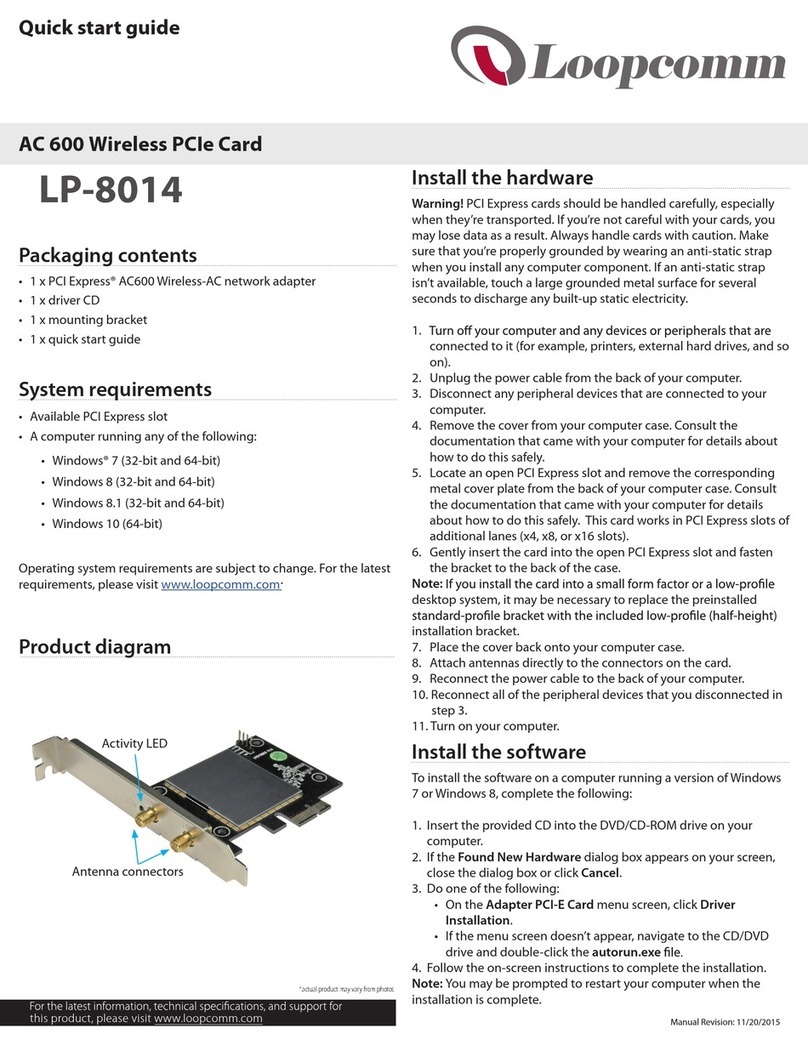
Loopcomm
Loopcomm LP-8014 quick start guide
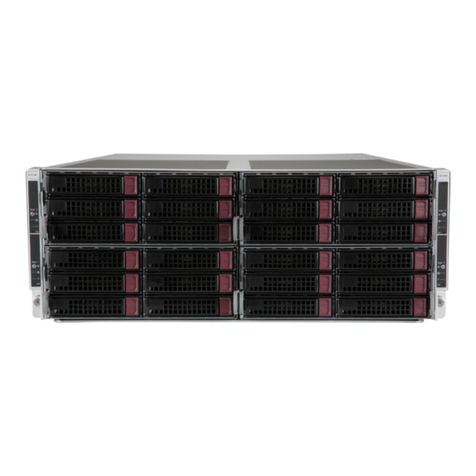
Supermicro
Supermicro FatTwin F620P3-RTBN user manual
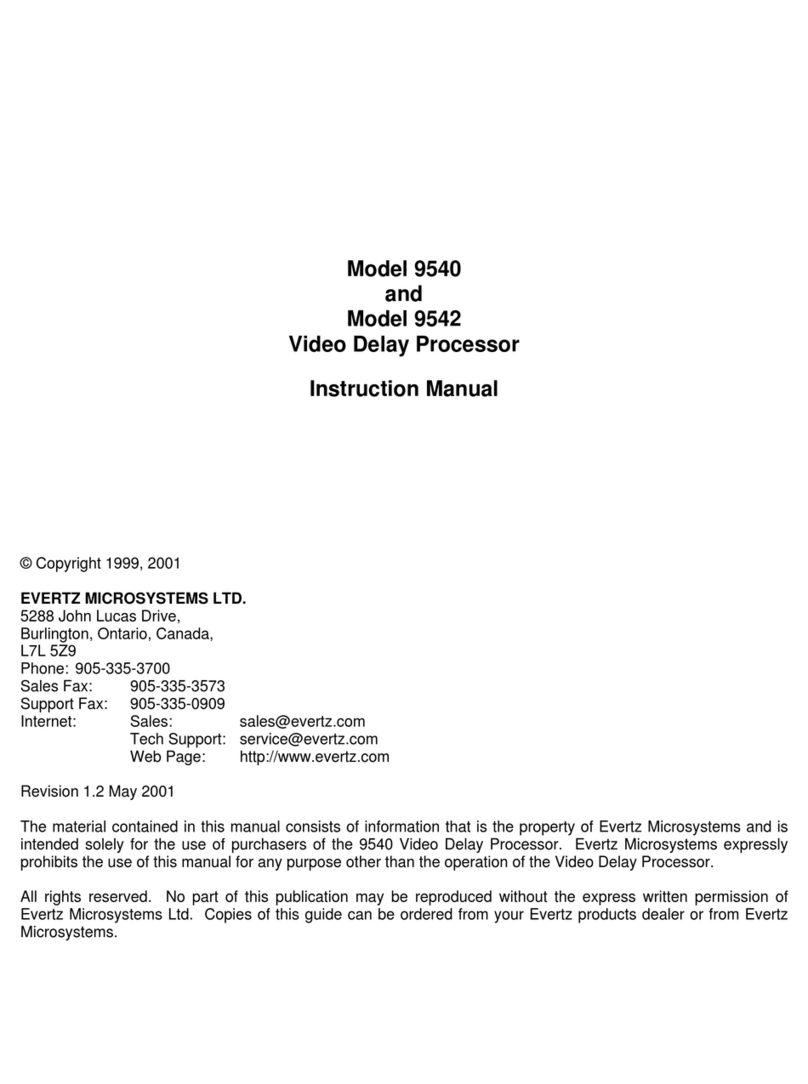
evertz
evertz 9540 instruction manual
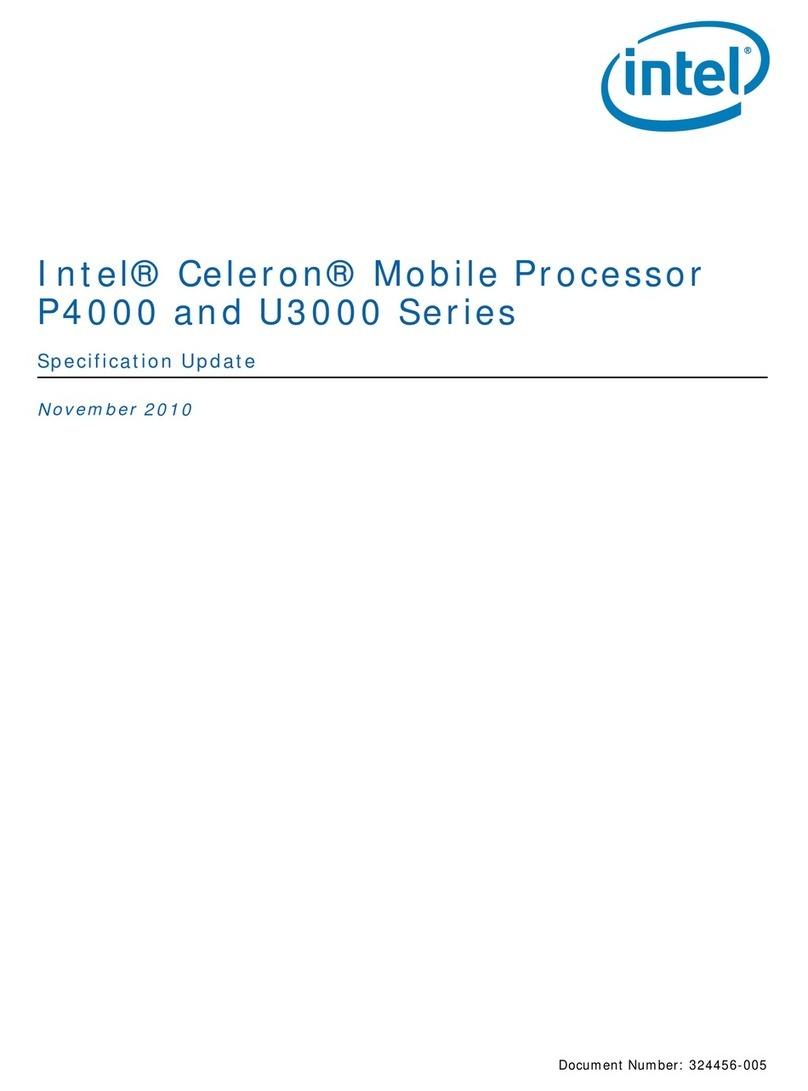
Intel
Intel P4000 - 11-2010 specification
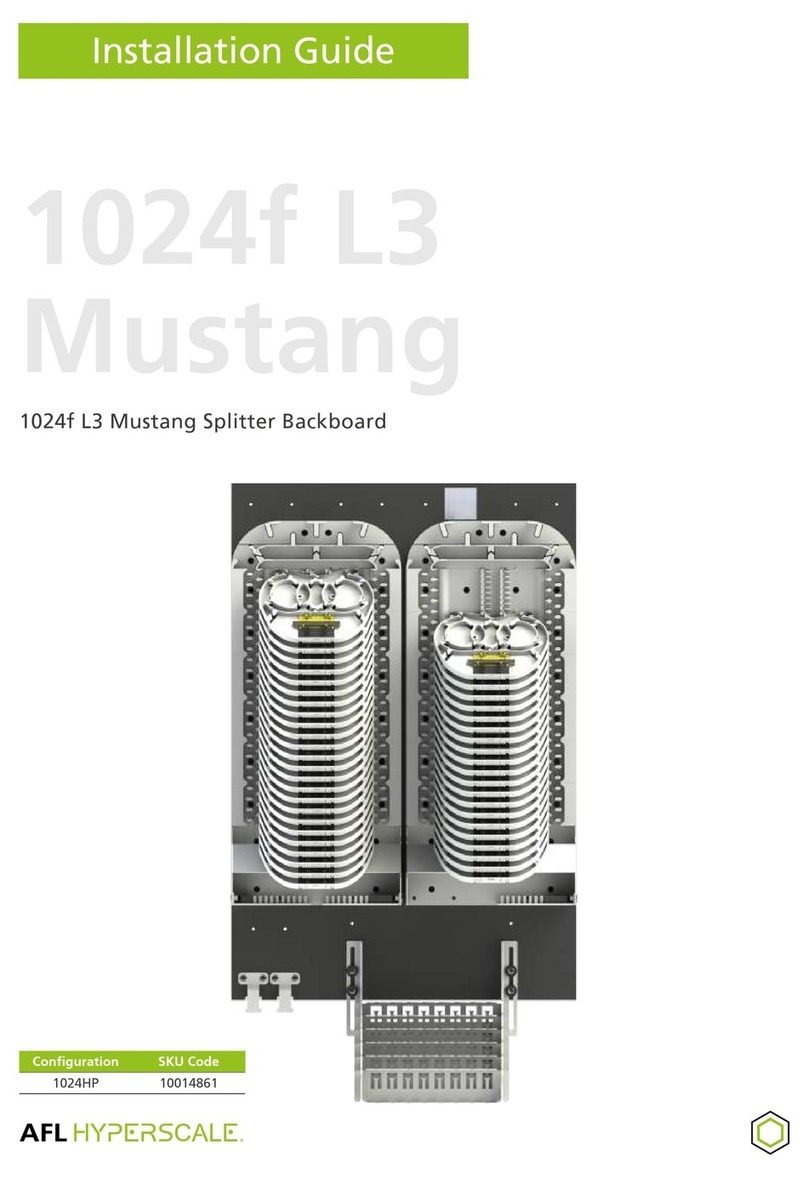
AFL Hyperscale
AFL Hyperscale 1024f L3 Mustang installation guide

Intel
Intel M50CYP2SB Series Technical specification
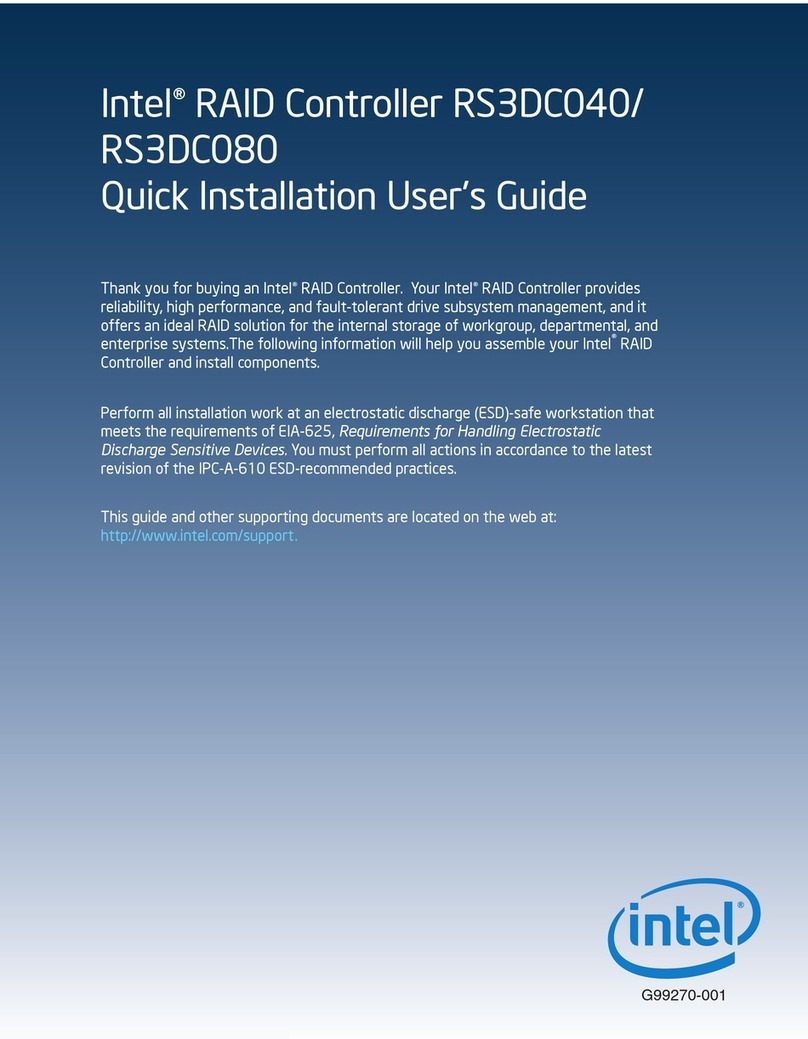
Intel
Intel RS3DC080 Quick installation guide
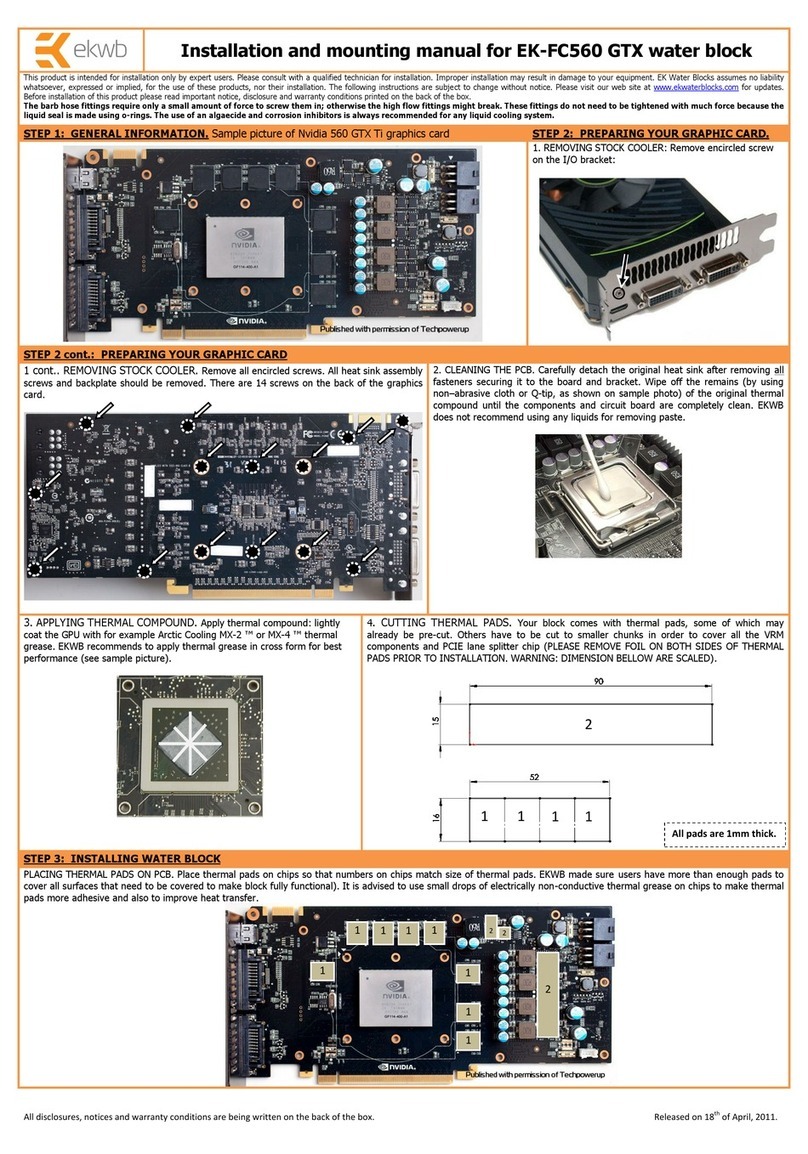
ekwb
ekwb EK-FC560 GTX INSTALLATION AND MOUNTING MANUAL
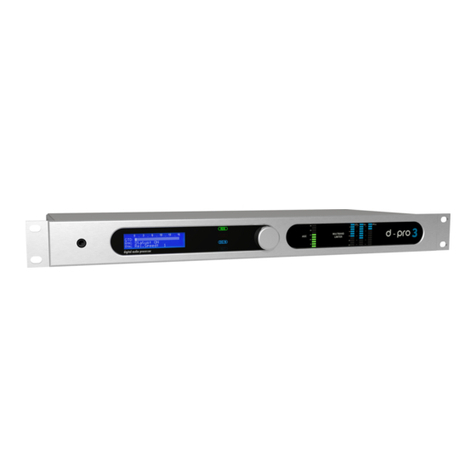
Itel
Itel DPRO3 user manual
NXP Semiconductors
NXP Semiconductors Androidi.MX 8M Mini quick start guide
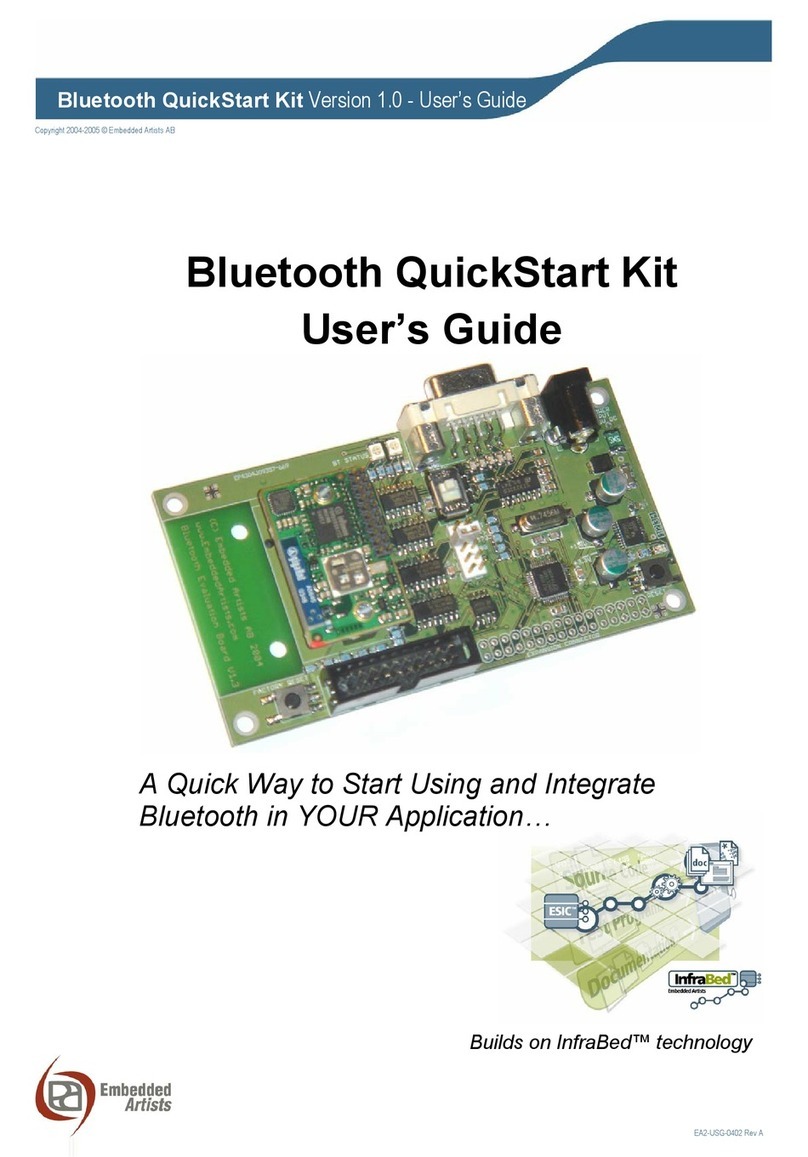
Embedded Artists
Embedded Artists Bluetooth QuickStart Kit user guide

